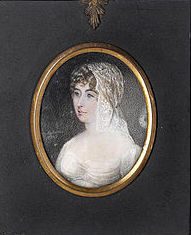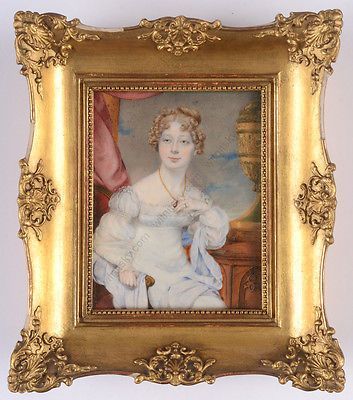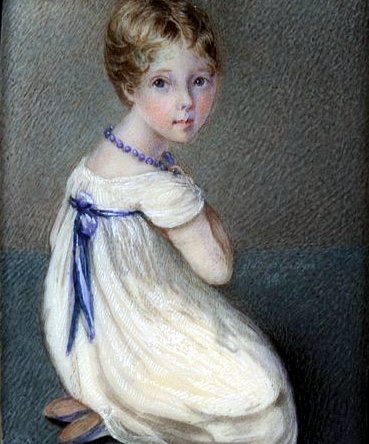BETHAM, Mary Matilda
Mary Matilda Betham was born at Stradbroke, Suffolk on 16 November 1776, eldest of the fifteen children of the Revd William Betham (17 May 1749-27 October 1839) of Stonham Aspal, Suffolk, later rector of Stoke Lacy, Herefordshire, and his wife Mary, née Damant (1752/3–1839), the widow of Whittocke Planque. William Betham, who died at Westerfield Hall, Ipswich was a distinguished antiquary and had a fine library which awakened Matilda’s interest in literature, especially of history. On visits to Cambridge, she studied Italian with Agostino Isola (1713-1797), who had also taught the younger Pitt (28 May 1759–23 January 1806) and William Wordsworth (7 April 1770–23 April 1850). Matilda taught herself miniature painting, and her portraits have great delicacy, but she remained too much of an amateur and her success was limited, her subjects included her father, Louisa Manners Tollemache, 7th Countess of Dysart (2 July 1745–22 September 1840), Louisa Grace Beauclerk, Duchess of St Albans (1777–1816), wife of Aubrey Beauclerk, 6th Duke of St Albans and Robert Southey (12 August 1774–21 March 1843) and she exhibited some forty of her works at the Royal Academy between 1804 and 1816. Belonging to a large family, she made efforts to turn her talents to practical account and exploited her large miscellaneous historical reading effectively in her 'Biographical Dictionary of the Celebrated Women of every Age and Country' (1804). Betham had already settled in London where she gave Shakespearian readings and had a brief but brilliant period of literary and artistic success. She came to be on friendly terms with Charles Lamb (10 February 1775–27 December 1834) and his sister Mary Anne Lamb (3 December 1764–20 May 1847), with Samuel Taylor Coleridge ((21 October 1772–25 July 1834), Robert Southey (12 August 1774–21 March 1843), Anna Laetitia Barbauld (20 June 1743–9 March 1825), and others. How high she stood in their esteem and liking may be gathered from their letters to her, including a laudatory verse epistle from Coleridge. This, and other correspondence, is printed in 'A House of Letters' (1905). Matilda had already published two small volumes of verse, 'Elegies' (1797) and 'Poems' (1808), which attracted little attention, but in 1816 her 'Lay of Marie' was well received. The work of the thirteenth-century poet Marie de France (fl. 1160–1215) was an encouraging precedent for a woman with literary ambitions, and Matilda's poem effectively challenges comparison with Walter Scott's 'Lay of the Last Minstrel'. Charles Lamb, who saw the volume through the press, thought it ‘very delicately pretty as to sentiment’. Southey and Allan Cunningham (7 December 1784–30 October 1842) were still warmer in their praise, Southey advising her to insert at the end of her fictitious 'Lay of Marie' the real 'Lais de Marie', to give her book an antiquarian value. Mary struggled her whole life financially and she tried to get employment using her painting skill, however her inability to afford clothing meant that her 'shabby' appearance prevented her from getting work and she first turned to the Royal Literary Fund in 1817. In her life Mary was admitted into an asylum twice by her parents, first in 1819 after suffering a mental breakdown. She believed she had been unjustly incarcerated, and once released she kept her address a secret so that her family could not find her and send her back. After being released she was given a one-of payment for travel; unfortunately, her family committed her to an asylum again in 1822. She did eventually retire to the country and relinquish her literary pursuits, but in her later years Mary returned to London where she maintained her friendships and love of literature. Her friendships remained. ‘I would rather talk to Matilda Betham than to the most beautiful young woman in the world’, said a young man of her in her old age. Mary Matilda Betham died at her home in Burton Street, London on 30 September 1852.
Royal Academy Exhibits
1804 723 Portrait of Mr Manners - miniature
751 Portrait of the Countess of Dysart - miniature
752 Portrait of Miss Manners - miniature
753 Portrait of Her Grace the Duchess of St Albans - miniature
1805 339 Portraits of Miss Rouse Broughton, F F Baker, Esq. Mr Comrie,
Miss M Betham and Mr Finucame - miniature
from 94 Wimpole Street, London
1806 657 Portrait of Sir C.R. Baughton - miniature
760 Frame with [5] portraits Miss Chesshyne, Lady Faucomberg... - miniatures
from 9 Foley Place, Portland Street, London
1807 846 Portrait of a Lady - miniature
875 Drawing of a Young Lady dancing - miniature
from 14 New Cavendish Street, Portman Square
1808 759 Gaiety - miniature
761 Portrait of a Lady - miniature
779 Portraits of Mr de Denville, Mr Southey the poet and C and G Betham - miniature
813 Portrait of Miss Armstrong - miniatures
1810 578 Portraits of Rev.W and Mr R G Betham, Miss Duncan and herself - miniatures
from 49 Upper Marylebone Street, Fitzroy Square
1811 585 Portraits of Rev. P. Stockdale and Miss B Betham
1812 458 Portrait of Rev. W. Betham
471 Portrait of Mrs Pymar
from 64 Upper Charlotte Street, Fitzroy Square, London
1816 609 Portraits of Mrs Colonel Gordon, Mrs J and Mrs R.G. Betham and Miss A. Dove
Works by This Artist

|
Sara Coleridge (Mrs. Samuel Taylor ColeridgePortrait miniature
|

|
Lady in a White GownWatercolour
|

|
Edith May SoutheyWatercolour on ivory
|